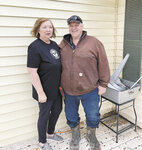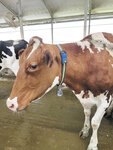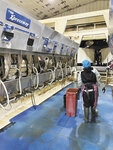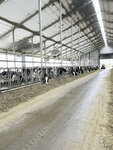



How many times a day do you milk, and what is your current herd average, butterfat and protein? We milk three times a day, and our rolling herd average is 30,800 pounds of milk with 3.8% butterfat and 3.2% protein.
Describe your housing and milking facility. Our freestall barn was built in 2002 and is naturally ventilated. The free stalls are bedded with sand. We milk in the double-8 parallel parlor that we built in 2000.
Who is part of your farm team, and what are their roles? My wife, Barb, is the farm’s bookkeeper. Our son, Kyle, is in charge of breeding, and our son, Dave, is the herdsman and takes care of herd health. We all pitch in wherever we are needed, especially during the busy fieldwork season.
What is your herd health program? Our veterinarian, Dr. Erika Nagorske, performs pregnancy checks every other week. We vaccinate all of our animals according to Dr. Nagorske’s vaccination schedule. It doesn’t pay to skimp on vaccines. Cleanliness is also important. We make sure that all of our milking equipment is sanitized and that the free stalls are kept clean and dry and have fresh sand.
What does your dry cow and transition program consist of? All of our cows are given a 60-day dry period. Dry cows are housed in a separate facility and are fed a ration that includes corn silage, ground corn stalks and a grain mix. When it’s available, we will give them grass hay instead of corn stalks. Immediately after calving, fresh cows are given two Bovikalc boluses. We don’t have a transition program. Fresh cows go straight from the maternity pen into one of our lactating groups.
What is the composition of your ration, and how has that changed in recent years? Our lactating animals are given a total mixed ration that consists of corn silage, haylage, cottonseed and a custom grain mix. We quit using dry hay in our lactating ration a few years ago because it got too expensive to buy. We have found that using haylage instead works just fine.
Tell us about the forages you plant and detail harvest strategies. We plant silage corn and alfalfa. We keep our alfalfa fields for three or four years before rotating them back to corn. Our goal is to harvest our corn silage and haylage at 68% moisture. We cut our alfalfa before it reaches the bud stage and let it lie for a day before we chop it. We apply manure immediately after each cutting. We were able to harvest five cuttings of alfalfa last year.
What is your average somatic cell count, and how has that affected your production? Our SCC typically ranges from 78,000 to about 100,000, which is good enough to get us into the Minnesota DHIA top 100 milk quality leaders. Keeping our SCC low has helped us maintain high milk production levels.
What change has created the biggest improvement in your herd average? Our mixer has helped increase our average the most, followed by going to three-times-a-day milking. Before we got the mixer, we would feed the cows baled hay with silage and a grain mix fed separately.
What technology do you use to monitor your herd? All of our cows have activity and rumination collars. The collars tell you right away if a cow is in heat or is feeling sick. We also put activity collars on our breeding-age heifers so that we can tell when they are ready to be bred.
What is your breeding program, and what role does genetics play in your production level? Our herd is 100% registered Holsteins. Mating suggestions are made by a Semex computer program. All of our breeding choices are made with a low SCC, good type, high production and sound udders in mind. Our grandkids like to show dairy cattle, so we always keep a few show cows around for them.
List three management strategies that have helped you attain your production and component level. Our mixer has helped us make a balanced ration on a consistent basis. The activity collars have helped us a lot when it comes to breeding and monitoring herd health. We use sexed semen, so we always have more heifers than we need. This allows us to be choosy when we decide which heifers should join our milking herd.
Tell us about your farm and your plans for your dairy in the next year. My wife, Barb, and I have been married for 49 years. I have milked cows my entire life. I started farming on my own on a rented farm in 1976 with a John Deere 4020 and a five-bottom plow. I moved here and bought out Dad in 1991. At that time, we had 60 cows and 30 heifers. I worked with my dad and my uncle until they retired. Kyle and Dave take care of all of the farm’s repair work. They also do custom fieldwork such as planting corn and hauling manure. Our plans for the next year are to simply keep on improving on what we have.
Comments
No comments on this item Please log in to comment by clicking here